Navigation
Install the app
How to install the app on iOS
Follow along with the video below to see how to install our site as a web app on your home screen.
Note: This feature may not be available in some browsers.
More options
You are using an out of date browser. It may not display this or other websites correctly.
You should upgrade or use an alternative browser.
You should upgrade or use an alternative browser.
Cochin Thread!!!
- Thread starter Settler'sDreamFarm
- Start date
Quote:
Thanks! I've decided I have to have one. Now the adventure has just begun.
I have a a poor quality pair for sale if you want them
 Rooster isn't bad, hen has very poor coloring and type both......her lacing is not clear.....big FAT hen though. It would be a start if you're interested.
Rooster isn't bad, hen has very poor coloring and type both......her lacing is not clear.....big FAT hen though. It would be a start if you're interested.
I'm not sure where to start. Kinda a newbie so don't know alot about breeding for certain qualities or how to fix them.

Thanks! I've decided I have to have one. Now the adventure has just begun.
I have a a poor quality pair for sale if you want them

I'm not sure where to start. Kinda a newbie so don't know alot about breeding for certain qualities or how to fix them.

Quote:
I have a a poor quality pair for sale if you want them
 Rooster isn't bad, hen has very poor coloring and type both......her lacing is not clear.....big FAT hen though. It would be a start if you're interested.
Rooster isn't bad, hen has very poor coloring and type both......her lacing is not clear.....big FAT hen though. It would be a start if you're interested.
I'm not sure where to start. Kinda a newbie so don't know alot about breeding for certain qualities or how to fix them.

If you haven't already done so, go back and read all the posts in this thread for about the past 2 - 3 weeks. We've talked a lot specifically about Golden Laced, and Cochinman2005 has been over the top in helping us with our breeding programs. They are beautiful, but breeding them is not for the faint of heart. But don't fret, we're all here to learn, and 99.99% of us have had our GL's for just a year or less, and are just in our first breeding season.
We might be able to help more if we know what your intentions are in obtaining GL's - your own personal backyard flock, breeding a line that you can sell as good quality birds, or possibly is showmanship in your future? Do you have a copy of the ABA SOP, so you can study both the breed and color variety requirements?
One thing I am learning very quickly - breeding the best pair you can buy is easy, but it in no way guarantees that the offspring will be of the same quality. They can be better; they can be worse. Depending on how serious you are, you may also want to pick up a book on genetics. If you have a lesser female, you might be able to pair her with a better male - one who excels where she is lacking, and vice versa. You don't have to start with 2 perfect birds. Find a pair where they each have traits that can compliment the other's faults. But then a big lesson comes in trying to learn exactly which traits you simply do not want to breed any further - some bad traits are just harder to overcome than others.
That's where I'm at right now - mine are just now coming on 3 months, and I'm losing sleep over making the right decisions as to who I'm going to keep and who has to go. I just don't have the facilities to keep them all over the winter. So I'm reading, studying, and seeking out the best advice I can on-line. And hopefully, next season I'll learn from the mistakes I make this year, and hopefully every year it will get a bit easier.
I have a a poor quality pair for sale if you want them

I'm not sure where to start. Kinda a newbie so don't know alot about breeding for certain qualities or how to fix them.

If you haven't already done so, go back and read all the posts in this thread for about the past 2 - 3 weeks. We've talked a lot specifically about Golden Laced, and Cochinman2005 has been over the top in helping us with our breeding programs. They are beautiful, but breeding them is not for the faint of heart. But don't fret, we're all here to learn, and 99.99% of us have had our GL's for just a year or less, and are just in our first breeding season.
We might be able to help more if we know what your intentions are in obtaining GL's - your own personal backyard flock, breeding a line that you can sell as good quality birds, or possibly is showmanship in your future? Do you have a copy of the ABA SOP, so you can study both the breed and color variety requirements?
One thing I am learning very quickly - breeding the best pair you can buy is easy, but it in no way guarantees that the offspring will be of the same quality. They can be better; they can be worse. Depending on how serious you are, you may also want to pick up a book on genetics. If you have a lesser female, you might be able to pair her with a better male - one who excels where she is lacking, and vice versa. You don't have to start with 2 perfect birds. Find a pair where they each have traits that can compliment the other's faults. But then a big lesson comes in trying to learn exactly which traits you simply do not want to breed any further - some bad traits are just harder to overcome than others.
That's where I'm at right now - mine are just now coming on 3 months, and I'm losing sleep over making the right decisions as to who I'm going to keep and who has to go. I just don't have the facilities to keep them all over the winter. So I'm reading, studying, and seeking out the best advice I can on-line. And hopefully, next season I'll learn from the mistakes I make this year, and hopefully every year it will get a bit easier.
Quote:
I agree that it's not so much that they are rare (although they certainly don't exist in the numbers you'll find in Black, White, Buff), as it is that better quality birds are rare.
Some times you have to resort to hatchery stock and do some calculated crosses. Time and patience.
I've checked my catalogs but haven't found any in the standard size. Bantam only.
I'm going to offer up an opinion that I know a lot may differ with. Many only want to buy eggs or chicks, because they don't want other people's "culls". If you are buying from a reputable breeder with a well established quality line, you can do extremely well buying their "culls" (I hate that word!). If you are buying birds at 6 months to a year or year and a half, they have already been thru a couple rounds of culling, and the worst traits have already been weeded out. Again, with a reputable breeder with a well established quality line, your chances are pretty good that the older the bird is, the better (assuming the bird is still of a good breedable age). IMHO.
I agree that it's not so much that they are rare (although they certainly don't exist in the numbers you'll find in Black, White, Buff), as it is that better quality birds are rare.
Some times you have to resort to hatchery stock and do some calculated crosses. Time and patience.
I've checked my catalogs but haven't found any in the standard size. Bantam only.
I'm going to offer up an opinion that I know a lot may differ with. Many only want to buy eggs or chicks, because they don't want other people's "culls". If you are buying from a reputable breeder with a well established quality line, you can do extremely well buying their "culls" (I hate that word!). If you are buying birds at 6 months to a year or year and a half, they have already been thru a couple rounds of culling, and the worst traits have already been weeded out. Again, with a reputable breeder with a well established quality line, your chances are pretty good that the older the bird is, the better (assuming the bird is still of a good breedable age). IMHO.
- Aug 26, 2010
- 94
- 2
- 39
Hello All, We picked up 4 "Cochin" pullets the other day from a local breeder. 2 Black and 2 Blue.
They were hatched in April and 2 in May (The larger ones). One of the larger Black ones looks to have longer sweeping tail feathers and the reddest comb. Is it a possible Roo?
My second question, do Cochin have ear Muffs and Beards???
All but the large blue girl seem to have muffs and beards. Will it fill in as they get more feathers?
Thanks for all input, please help us confirm what we have!!!!
Group of our cochins (4 and 5 months old)

Roo or Pullet?

Cochins, with muffs

Roo to the far left?

Blue cochin pullet with no muffs or beard



Picture of their tails

Face



Feet, some plucked off in transit, but seem a bit bare in general

Thanks again for any input!
They were hatched in April and 2 in May (The larger ones). One of the larger Black ones looks to have longer sweeping tail feathers and the reddest comb. Is it a possible Roo?
My second question, do Cochin have ear Muffs and Beards???
All but the large blue girl seem to have muffs and beards. Will it fill in as they get more feathers?
Thanks for all input, please help us confirm what we have!!!!
Group of our cochins (4 and 5 months old)
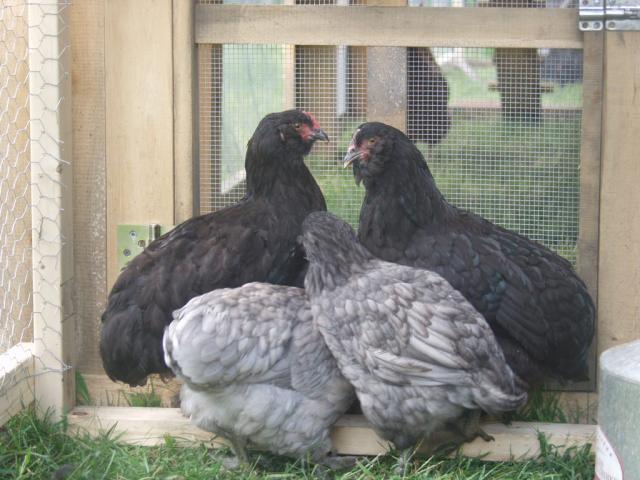
Roo or Pullet?

Cochins, with muffs

Roo to the far left?

Blue cochin pullet with no muffs or beard


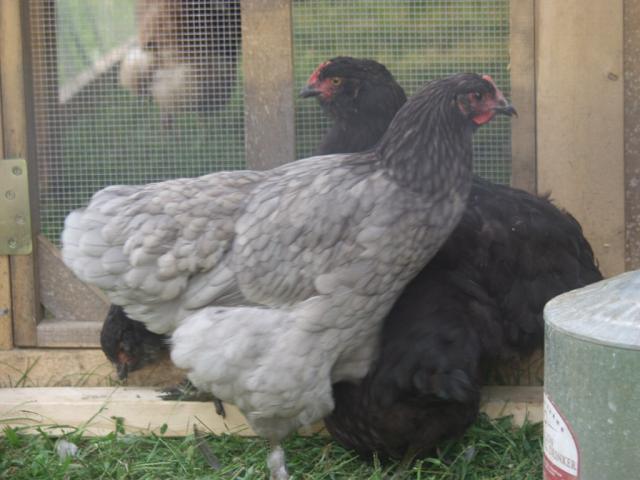
Picture of their tails
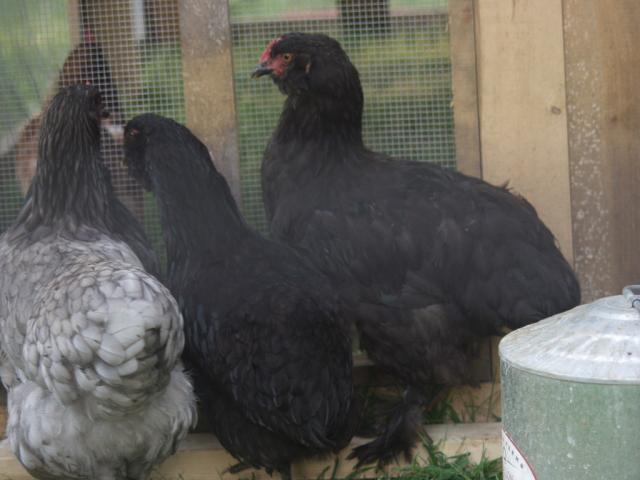
Face
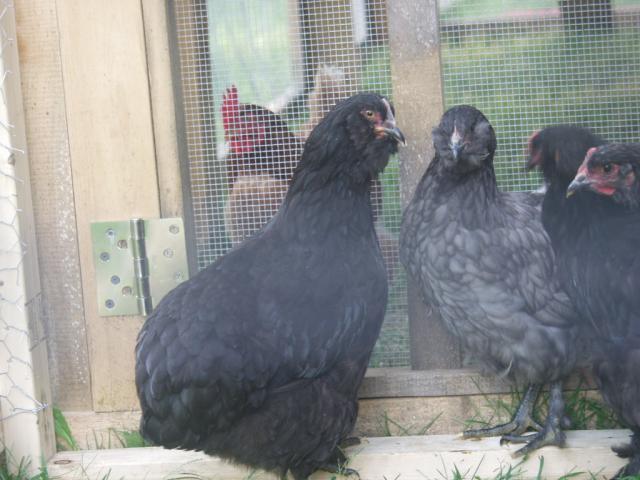


Feet, some plucked off in transit, but seem a bit bare in general
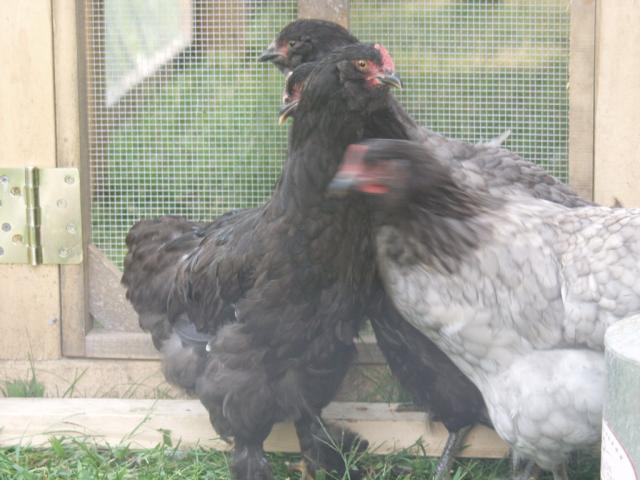
Thanks again for any input!
- Dec 21, 2009
- 1,433
- 18
- 153
They almost look more like faverolles....try posting on their thread!
It is my understanding that cochins do not have any muffs/beards. cochin/? mix perhaps?
Quote:
Quote:
Quote:
Cochins don't have beards and muffs. Probably a mix with Faverolles, Ameraucanas or EE's. But pretty - enjoy them. Looks like you might have 2 pairs.
Cochins don't have beards and muffs. Probably a mix with Faverolles, Ameraucanas or EE's. But pretty - enjoy them. Looks like you might have 2 pairs.
- Aug 26, 2010
- 94
- 2
- 39
Thanks for the replies, when we went to pick them up they did not have the ball shape that I was expecting. They had the "Pants" and some Feathers on their feet. I figured that they were young and had not fully feathered as plump as they should/ will be.
I did fall for their beauty though, which tends to make you blind.
You mentioned two possible pairs, do you think the larger black one and blue one are roos?
Thanks again
I did fall for their beauty though, which tends to make you blind.
You mentioned two possible pairs, do you think the larger black one and blue one are roos?
Thanks again
Quote:
I think you might have 2 roos there they look like EE/cochins to me very pretty birds
I think you might have 2 roos there they look like EE/cochins to me very pretty birds

New posts New threads Active threads
-
Latest threads
-
Help! Duckling with suspected Curly Toe Paralysis and don't know what to do
- Started by shadofox
- Replies: 0
-
Need help figuring out best combo for breeding my cuckoo silkie roosters
- Started by ChickenMathizCrazy
- Replies: 0
-
Crazy Factory color mess-up?
- Started by ChickenMathizCrazy
- Replies: 0
-
Marans club USA, is it a waste of money?
- Started by Kung_pao
- Replies: 3
-
-
-
Threads with more replies in the last 15 days
-
-
-
-
Heater or heat panel -10
- Started by IowaCHKN
- Replies: 94
-
-
×

